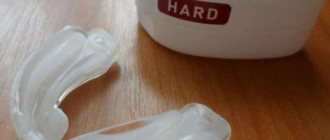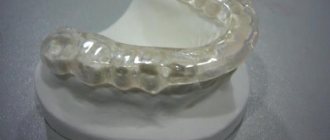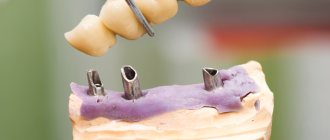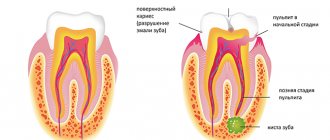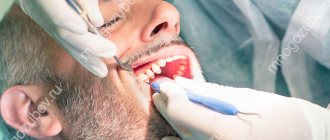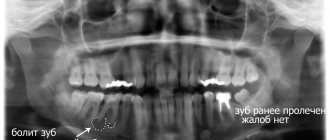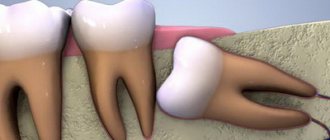Hemisection of a tooth is an invasive dental procedure that is aimed at removing one of the roots of multi-rooted units, including its coronal part. It is carried out when conservative treatment of inflammatory processes affecting part of the root does not give the desired result. Along with apicoectomy and cystotomy, it is tooth-preserving, but in order for it to be possible, the remaining roots must not be involved in the pathological process. Its task is not only to stop inflammatory processes and save the tooth, but also to eliminate the risk of inflammatory damage to the jaw bone tissue and its atrophy, which develops after the entire tooth is removed.
The surgical department of dentistry CELT invites you to undergo root hemisection in Moscow. Our multidisciplinary clinic has been offering paid medical services for the third decade. We employ leading domestic dental surgeons, who have a powerful diagnostic and treatment base in their arsenal. It allows you to make an accurate diagnosis, plan the operation in detail and carry it out in accordance with international standards. You can find out the estimated cost of tooth hemisection by going to the “Services and Prices” tab. Despite the fact that we regularly update the price list, we ask you to check the exact numbers with the information line operators or at your doctor’s appointment.
Consultation with a dental surgeon - 700 rubles.
Hemisection of a tooth - 2,600 rubles.
At CELT you can get advice from a dental specialist.
- The cost of a consultation with a dental surgeon is 700
Make an appointment
The essence of the method
If a tooth has several roots, on one of which a granuloma or cyst has formed, complete removal is not necessary. Hemisection involves amputation of the affected part, leaving healthy tissue unaffected. After the operation, the natural support of the tooth is preserved, so restoration and restoration of chewing function is possible. Your own tooth is better than any modern implant. If it is possible to save it, you should do so.
What symptoms indicate the appearance of a granuloma on the root of a tooth?
Over a long period of time, granuloma on the root of a tooth can develop asymptomatically, and this makes diagnosing the disease in the early stages of development extremely difficult. However, some signs may be present during the initial phases of granulomatosis.
Among them:
- The appearance of dental hypersensitivity to external irritants: hot/cold, sweet/sour foods;
- Bursting sensations in the gum next to the tooth, on the root of which a granuloma has formed;
- A slight aching pain, most often occurring when biting;
- Change in color of the enamel of a diseased tooth.
If you observe similar signs in yourself, it’s time to contact your dentist to diagnose and begin treatment for granuloma! Our advanced dentistry clinic in Moscow, Firadent, uses modern diagnostic techniques and innovative equipment to help identify complex dental diseases in the early stages and carry out effective treatment!
Chronic apical granuloma of the tooth will sooner or later go into the acute phase of development, in which the disease acquires clear signs:
- Acute pain that intensifies when biting and chewing food;
- Feels as if the tooth has become larger or is growing;
- Swelling of the gums and cheeks.
If you ignore these symptoms and do not consult a doctor to remove the dental granuloma, the intensity of the pain will increase, the swelling of the gums and swelling of the face will increase, purulent discharge may begin from the gums, a severe migraine, general weakness, and high temperature may appear. There is no need to try to endure such symptoms - seek professional dental help immediately!
How to treat tooth root granuloma in dentistry: all modern methods of treatment/removal of granulomas
What to do if you notice symptoms of granuloma? Of course, seek help from a dentist, because granulomatosis cannot be treated at home: neither antibiotics nor folk remedies will help. Treatment will begin with diagnostics, during which radiography or radiovisiography is performed. If you have a granuloma, the image will show a darkening at the root of the diseased tooth. Diagnostics will allow you to determine the shape of the granuloma (apical or periapical), assess the stage of development of the tumor, and choose the most effective treatment method for granulomatosis.
Treatment for granuloma can be:
- 1. Conservative (medication).
- 2. Surgical, involving the removal of tooth root granuloma.
We will consider all these methods and their features in detail below.
Indications
The operation is performed only on teeth that have two or more roots. After removing the affected area, a root should remain that firmly holds the tooth. Indications for hemisection are:
- inability to treat the root;
- cyst;
- granuloma;
- perforation;
- root caries;
- the impossibility of cleaning the canals due to their irregular shape or small diameter;
- chronic periodontitis;
- mechanical damage.
Hemisection is also performed in childhood. Dentists are often faced with the impossibility of endodontic treatment due to tortuous canals. But preserving a child’s tooth is important, since prosthetics using implants is only possible in adults, and many children refuse to wear a removable denture.
Preparation stage
Before hemisection of a tooth is performed, the patient undergoes preparation, which may include the following steps:
- removal of the nerve followed by filling;
- elimination of infectious foci (if present in the body);
- X-ray of the tooth root;
- orthopantomogram (panoramic photograph of a tooth or the entire jaw).
A diagnostic hardware examination of the root is necessary in order to identify the degree of possible risk and determine the presence or absence of contraindications.
Contraindications
The operation is not performed on teeth that have one root, or when the other roots are also affected. In these situations, it is impossible to save the tooth because it has no support.
Fused roots are another obstacle to tooth-preserving surgery. In this case, it is impossible to separate the affected tissues from healthy ones.
The operation is not performed in elderly patients or in patients with severe somatic diseases: diabetes mellitus, oncology, kidney damage, or cardiovascular disease. If there are doubts that a person will safely undergo hemisection for health reasons, it is better to remove the tooth.
Advantages and disadvantages
The technique allows us to ensure the safety of even hopeless teeth. The restoration will have to be done with a crown, but it will have natural support. It is safer and more reliable than the introduction of an artificial implant.
The operation rarely leads to complications. With the correct technique for performing the procedure and proper preparation, the dentist can achieve results.
The remaining part of the root cannot restore the tooth to its former strength. For this reason, it is recommended to limit chewing loads and not use teeth after hemisection as support for bridges. There is no guarantee that the root will maintain its integrity for several years.
Postoperative complications include: bleeding, secondary infection, suture dehiscence. This often occurs when the rules of asepsis and antisepsis are violated during manipulation and the patient does not comply with the doctor’s recommendations during the rehabilitation period.
Postoperative care
What should you do after removing part of the root? Three days after surgery it is recommended:
- rinse your mouth with soda or salted water (warm) after any meal;
- to eliminate pain, you can take analgesics - solpadeine, analgin;
- take anti-inflammatory drugs as prescribed by your dentist;
- take antibacterial/antihistamines as recommended by your dentist;
- take prescribed antibiotics in strict accordance with the doctor’s recommendation, even if you feel good;
- take vitamin complexes;
- take medications that increase immune defense.
Healthy, well-groomed teeth are important not only for the aesthetics of a smile: they are a guarantee of a person’s overall health. Well-chewed food makes the work of the stomach and intestines easier: the mucous membrane is less abraded, and cell renewal occurs less frequently.
Good, strong teeth also extend a person’s life, because well-chewed food is absorbed faster, and the body spends less energy processing coarse food particles. Take care of your teeth and visit the dental office regularly. You should not be afraid of the sound of a drilling machine: timely treatment of caries is not as painful as surgery on the jaw bone tissue.
Sources used:
- Methods of isolating the working field in dentistry: monograph. / Edited by I.M. Makeeva. - M.: MEDpress-inform, 2007.
- Practical therapeutic dentistry" (Nikolaev A.)
- Petrov S.V., General surgery, St. Petersburg, Publishing house "Peter", 2002
- British Orthodontic Society
Operation technique
Hemisection refers to volumetric surgical interventions. The procedure lasts 1.5-2 hours. For pain relief, local or general anesthesia is used. The choice depends on the individual characteristics of the patient and the technique used.
Hemisection can be performed by two methods: access from above or by peeling off a skin flap.
When choosing the first method, the crown is sawed to the point where the roots emerge. In this way, the affected root, together with part of the crown, is separated from healthy tissue. After separation, the damaged area is removed.
The second method is carried out by cutting the gums. In the area of projection of the affected area, the flap is peeled off, part of the root is sawed off and removed. Stitches are applied.
After removing one of the roots, a void remains in the jaw. If left, it will fill with granulation tissue, which is considered an unfavorable outcome. To prevent this, artificial bone is poured into the cavity and covered with a membrane. The material is biocompatible and is rarely rejected.
Prosthetics are not performed immediately after surgery. We need to wait for complete healing. This takes at least a month. If the recovery period passes without complications, a crown can be installed. Sometimes, to increase strength, stump inlays are used to evenly distribute the load on the root and protect it from fracture.
Application of the technique in dentistry
The surgical technique is used by specialists in the following cases:
- if surgical treatment is necessary for adolescents. Tooth extraction can negatively affect the formation of the bite;
- hemisection is used to eliminate a tumor located in close proximity to the root. The use of the technique allows you to excise only the pathological area without affecting healthy tissue;
- removal of only one root will solve the problem of treating its fracture and preserve the healthy part of the organ;
- root amputation using hemisection allows you to eliminate long-term infectious inflammation of surrounding tissues, which cannot be treated by other methods;
- surgery may be required to eliminate the purulent focus. If an accumulation of inflammatory fluid has formed in one of the roots, it is not necessary to remove the entire organ to remove it; it is enough to perform a hemisection;
- in some cases, it is impossible to cure the carious process by cleaning and filling all root canals due to their complex anatomical structure. This circumstance especially concerns narrow root canals. In this case, surgical intervention will help eliminate the pathological process - excision of the root and part of the crown;
- hemisection of a tooth is the most gentle way out of a situation when it is necessary to remove a dental instrument stuck in the root canal.
Possible complications
Bleeding may occur during the operation or after the intervention. This is relevant for people with poor blood clotting, taking antiplatelet drugs, and smokers. For this reason, intervention is not recommended for patients with bleeding disorders. If you are taking some medications regularly, you may need to temporarily stop them. You will have to give up cigarettes before hemisection and in the postoperative period.
The tooth, part of which is removed, usually shows signs of inflammation and serves as a source of infection. Insufficiently thorough sanitation of the lesion during surgery can lead to the development of a secondary inflammatory process. The reason may also be improper treatment of the dentist’s hands and unsterile instruments. The infection can be caused by the patient himself after treatment. Failure to maintain oral hygiene and ignoring doctor's recommendations often lead to serious purulent complications.
Even after a successful operation, there is no guarantee that the remaining root will cope with the increased load. Sometimes the tooth has to be removed several months after hemisection.
Cost of services
The Martinka Children's and Adolescent Clinic is a modern dental center that provides all services at the European level. Our dentistry is one of the few in Moscow that treats children using the hemisection method. Treatment of young patients is possible only after preliminary consultation and examination.
You can make an appointment with a dental surgeon at our clinic, find out the price for hemisection and other information of interest on the website of the Martinka dental clinic or by calling the contact phone number. Pre-registration allows you to visit a specialist at a time convenient for you. When indicated, our clinic also provides emergency appointments for children.

